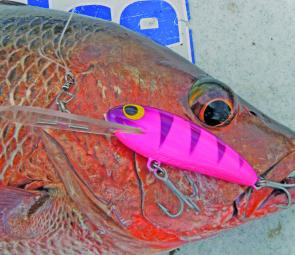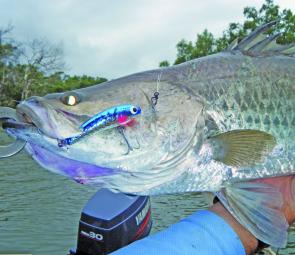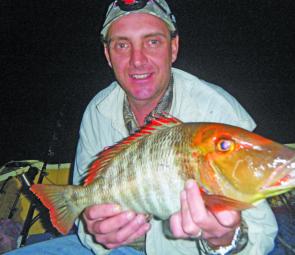As I drive past the Lucinda caravan park I’m noticing only a handful of tents and vans, and this number is diminishing daily. This can only mean one thing: the heat, humidity and rain has arrived with the coming wet season.
The summer months can be tough in the tropics but empty boat ramps mean more fish for us who are lucky enough to live here. Visitors that stay should be treated to some great fishing and more than one opportunity to see how water proof their rain coat really is.
From midday November 1 through to midday February 1 is the barra closed season. With the amount of barra in the system at the moment these few months of breeding will mean great things for many years to come. During this time you can't target barra and any accidental captures should be released as quickly and stress free as possible. Leave fish in the water to release if possible. There are very heavy consequences for those who don't follow the rules.
It is this time of the year that the mangrove jack really come out to play. I am not the only fisho that would put jacks on top of their favourite fish list, jacks demand respect and you need to be on the ball to stop them.
Jacks will be spread throughout the system, from the creeks to the rock bars off the island. It is best to target them in the last half of the run-out tide using lures or baits. Jacks are not fussy and as they are so aggressive they will eat live baits or dead baits with fresh mullet fillet or pilchards being the best.
Fishing unweighted pilchards into heavy structure is a deadly technique and hard to beat. The 'slap' on the water as the pillie lands attracts the attention of any fish, time in the strike zone is maximised as an unweighted pillie slowly drifts and sinks. Then it’s game on as all hell breaks loose.
If the pillie hits the bottom then slowly retrieve it out of the snag and recast in a different location. Be prepared to get hit when retrieving the bait, as fish are attracted by movement and jacks don’t want to let a bait get away
Don't be scared to get it right into the structure as no sinker and minimal hook exposure means a near snagless bait, however pulling the bait and fish out is another story. You can cover a lot of ground using this technique making it effective for areas that offer plenty of structure.
Using artificials is my preferred method of chasing jacks. I love to find plenty of snags in an unforgiving creek and twitch hardbodied lures. It is addictive and intense fishing as the fight is won or lost in the first few seconds.
Here at Lucinda we are offered a near never ending maze of creeks and finding a nice snaggy section is simple. Most creeks offer more structure the further you head up them. Both Waterfall and Bluff creek are great as they are close and offer plenty of big snags and rock bars. Nemes Creek is also big and offers hundreds of metres of snaggy banks.
Don't discount night sessions as jacks move around more during darkness. Those dead still and humid nights are perfect for breaking out the smaller poppers or plastics. Fishing sand and mud flats with structure close by on the rising tide during the night can be very rewarding, just remember to pack the insect repellent.
I’ll take this opportunity to remind you not to get to attached to your lures as jacks love to take them home and hang them on their walls. Screw your drags up tight...then use your thumbs!
Plenty of mackerel are still being caught but this run will slow down as the water warms. The big schools of mackerel will disappear but the odd XXL Spaniard will still be around. As there are so many reef and islands in the area it really pays off to troll from one spot to another. Keep one eye glued to your sounder and a finger on the mark button to mark GPS points for any bait schools, bottom structure, water temp change or fish.
Trolling a good spread of different lures is important as it keeps your options open. For instance if trolling three rods using a deep diver, shallow diver and a skirted lure will cover three different areas and give you the chance of hooking anything from mackerel and tuna to marlin and sailfish or GTs and queenfish.
Depending on water depth big coral trout love to smash a trolled lure. For the family trolling also means time to sit back relax, eat some snacks and wait for the rod to load up and line scream off the reel.
These warmer months are the time to be out in the shipping channel between the reef and Hinchinbrook Island chasing small black marlin, there should be plenty of fish harassing the bait schools. Keep an eye out for birds working bait schools as the fish will be near by.
Trolling around (not through) these schools with skirted lures or skip baits will hopefully see you hooked up in a big way. Securing live baits and drifting them on the edges of these bait schools is also a great technique and worth a try if trolling isn't working.
Around the palms there are some good red throat and smaller reef jacks being caught for those prepared to put in long hours trying to find them. Last month we had a fishing session from dusk until dawn and only found fish after about a dozen changes in location. In this situation trying different water depths, current flow and baits is crucial.
North Queensland waits for another wet and cyclone season, and we just don’t know what Mother Nature has in store for us. What I do know is that pouring rain, searing humidity and thermometer breaking heat won’t be keeping me from the water.
Reads: 1850
About two casts later and his mate stole this lure, no questions asked.

Barramundi are currently off the list, but will be well worth the wait come February.

Sometimes you need both sleepless nights and persistence to score a fish.




